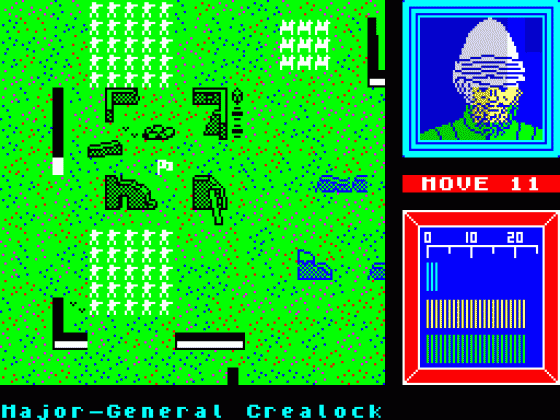
C&VG
 1st August 1987
1st August 1987
Publisher: Cases Computer Simulations
Machine: Spectrum 48K
Published in Computer & Video Games #70
Zulu War
Zulu War, for the Spectrum only, is a single-player tactical level game against the computer.
This is itself a pity. The real Zulu War of 1879, like all the 19th century colonial wars, was a struggle between a small regular force with little local knowledge and manoeuvrability, but devastating firepower, that could virtually guarantee a win a major set-piece battle, and a large number of highly mobile native forces, with less firepower but far greater hand-to-hand fighting ability, that could inflict a major defeat on any unprepared or divided force.
A far more interesting game could be made of the Zulu War by a two-player strategic program, with plenty of scope for hidden movement.

This game offers two scenarios - the final battle of Ulundi, in which the power of the Zulu was broken, and a hypothetical battle against the British second column, which was never seriously attacked, taking place at Umlalazi.
That the game needs a fictitious battle shows just how difficult the writers found selecting a battle in which the Zulu have a chance.
In the real battles the British stood shoulder-to-shoulder behind temporary defences of carts and mealie-bags. With their new longer-range breech-loading Martini-Henry rifles they were able to devastate the Zulu rushes before they ever closed to contact. Only as Isandhlwana, where the British were surprised with half their forces elsewhere, deployed with too wide a gap between units, and failed to keep up the ammunition supply, did the Zulu break through to contact.
At Ulundi, with many Zulu already dead from the earlier battles, the British deliberately chose not to fight from behind defences, but formed a hollow square of infantry with cavalry inside it, and blasted any Zulu coming near before unleashing the cavalry for a final charge.
I tried these tactics in the game's Ulundi scenario and was massacred. The game allows the British rifles such a limited range that they got only one volley before the far faster Zulu are upon them, and in hand-to-hand they stand little chance.
The game shows the British forces as square blocks, at first five figures by five, then shrinking to four by four and so down. This works very well, producing gaps in formations and forcing the British to close towards the centre each time. But the only way to even survive the Zulu rush is take up cover behind walls in a nearby abandoned village. The Zulu advance apparently at random, but in such a way that they maintain a broad general direction towards the enemy.
So, this is probably the wrong game to play for the Zulu War, and even as a representation of Zulu War tactics it isn't good.
But the game mechanism is a wonderful one for showing a disciplined army, used to fighting in formation, against an irregular force of higher mobility.
CCS have here the basis of a really excellent series of games set in the ancient period, with say Romans against Ancient Britons or Alexander the Great against the Persians. The ability of the irregular force to create gaps in the regular lines and infiltrate through them is offset by the higher regular firepower and stability with heavy losses.



